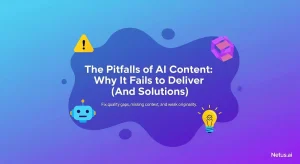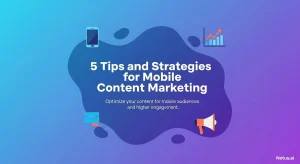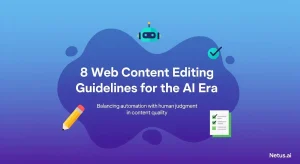Would an AI that Detects Fake News be Helpful? Exploring the Potential Benefits and Limitations
Ashley Merit
Content writer and editor for Netus.AI
Table of Contents
Would an AI that Detects Fake News be Helpful? Fake news has become increasingly prevalent in today’s society, with misinformation being spread at an alarming rate through various media platforms. This has led to a growing concern about the impact of fake news on democracy and the public’s trust in institutions. As a result, there has been a growing interest in developing artificial intelligence (AI) that can detect and combat fake news.
AI has the potential to play a crucial role in the fight against fake news. With advanced algorithms and machine learning capabilities, AI can quickly analyze large amounts of data and identify patterns that suggest a story is fake. This could help to prevent the spread of misinformation and restore public trust in the media. However, there are also concerns about the potential limitations of AI in detecting fake news, as well as the ethical implications of relying on machines to make decisions about what is true and what is not.
Understanding Fake News
Definition and Impact
Fake news refers to false information that is deliberately spread to misinform or deceive people. It can have a significant impact on society, especially when it is spread through social media and news outlets, as it can influence people’s opinions and decisions. The internet has made it easier for fake news to spread rapidly and reach a wider audience, making it a growing concern for many.
Sources and Spread
Fake news can originate from various sources, including individuals, organizations, and even foreign governments. It can be spread through social media platforms, such as Facebook and Twitter, as well as through websites and news outlets. The spread of fake news can be fueled by confirmation bias, where people tend to believe information that confirms their existing beliefs and ignore information that contradicts them.
To combat the spread of fake news, there have been efforts to develop AI systems that can detect and flag false information. While this technology has the potential to be helpful, it is important to note that AI is not infallible and can make mistakes. Additionally, there are concerns about the potential for AI to be used to censor legitimate information or to further political agendas.
Overall, understanding the nature and impact of fake news is crucial in developing effective strategies to combat its spread. By promoting media literacy and critical thinking skills, individuals can become better equipped to identify and avoid false information, while AI systems can provide an additional layer of protection against the spread of fake news.
AI in News Verification
Fake news has become a major concern in recent years, with the rise of social media and the ease of sharing information online. As a result, there has been a growing interest in using artificial intelligence (AI) to detect and combat misinformation. In this section, we will explore the role of AI algorithms in news verification, along with the challenges that come with using these tools.
Role of AI Algorithms
AI algorithms can play a significant role in detecting fake news by analyzing large amounts of data and identifying patterns. Natural language processing (NLP) and neural networks are two techniques commonly used in AI algorithms for news verification. NLP helps machines to understand human language, while neural networks can learn from data and improve their accuracy over time.
One of the key advantages of using AI algorithms for news verification is their speed and efficiency. AI tools can analyze large amounts of data in a short amount of time, which can be particularly useful in breaking news situations where time is of the essence. Additionally, AI algorithms can help to reduce the workload of fact-checkers by automating some of the verification process.
Machine Learning in Detection
Machine learning algorithms can be used to train AI tools to detect misinformation. These algorithms can learn from labeled data and improve their accuracy over time. However, it is important to note that machine learning algorithms are only as accurate as the data they are trained on. If the training data is biased or incomplete, the algorithm may not be effective in detecting fake news.
To overcome this challenge, it is important to use diverse and representative data when training AI algorithms for news verification. Additionally, it is important to continuously monitor and update the algorithm to ensure its accuracy.
Challenges for AI Tools
While AI algorithms can be effective in detecting fake news, there are also several challenges that come with using these tools. One of the biggest challenges is the sheer volume of information available online. AI tools must be able to analyze large amounts of data from various sources to identify patterns and detect misinformation.
Another challenge is the constantly evolving nature of fake news. Misinformation can take many forms, and new techniques for spreading fake news are constantly emerging. AI tools must be able to adapt to these changes and continuously improve their accuracy.
In conclusion, AI algorithms can be a valuable tool in the fight against fake news. However, it is important to use these tools in conjunction with human fact-checkers to ensure accuracy and avoid bias. By combining the strengths of AI and human expertise, we can work towards a more informed and truthful society.
Case Studies and Applications
Social Media Platforms
Social media platforms such as Facebook, Twitter, and YouTube have been criticized for their inability to prevent the spread of fake news. In the wake of the 2016 U.S. presidential election, these platforms have taken steps to combat fake news by partnering with fact-checkers and implementing algorithms to detect false information.
Facebook, for example, has implemented a system of fact-checking that involves partnering with third-party organizations such as Snopes and PolitiFact. When a post is flagged as potentially false, it is sent to these organizations for review. If the post is found to be false, it is labeled as such and its distribution is reduced.
Twitter has taken a different approach by introducing a feature that allows users to report tweets that they believe contain false information. The platform also labels tweets that have been fact-checked by verified organizations.
YouTube has also implemented a system of fact-checking by displaying information panels next to videos that contain information that has been fact-checked by third-party organizations.
Fact-Checkers and Organizations
Fact-checkers and organizations such as FactCheck.org, Snopes, and PolitiFact play a critical role in detecting and debunking fake news. These organizations employ journalists and researchers who investigate claims made in news articles, social media posts, and political ads.
Fact-checkers and organizations use a variety of methods to verify the accuracy of information, including reviewing official documents, conducting interviews with experts, and analyzing data. Once they have determined the accuracy of a claim, they publish their findings on their websites and social media platforms.
Grover, an AI-powered fact-checking tool, is an example of how technology can be used to combat fake news. Grover uses machine learning algorithms to analyze news articles and identify false information. The tool has been shown to be effective in detecting fake news, but it is not yet widely available.
Overall, the use of AI to detect fake news has the potential to be a valuable tool in the fight against misinformation. However, it should be used in conjunction with human fact-checkers and organizations to ensure that accurate information is being disseminated.
Technological Advancements and Research
Natural Language Processing
Natural Language Processing (NLP) is a subfield of artificial intelligence that focuses on the interaction between computers and human languages. NLP has been instrumental in detecting fake news by analyzing the language used in news articles. Researchers have developed NLP algorithms that can identify patterns and anomalies in the language used in news articles to determine whether the article is fake or not.
To train these NLP algorithms, researchers use large datasets of news articles, some of which contain fake news. The algorithms are trained to identify the patterns and anomalies in the language used in both real and fake news articles. This training data is crucial for the accuracy of the algorithms in detecting fake news.
Deep Learning Models
Deep learning models are a type of machine learning that uses neural networks to learn from data. These models have been successful in detecting fake news by analyzing the content of news articles. Researchers have developed deep learning models that can identify patterns and anomalies in the content of news articles to determine whether the article is fake or not.
To train these deep learning models, researchers use datasets of news articles, some of which contain fake news. The models are trained to identify the patterns and anomalies in the content of both real and fake news articles. This training data is crucial for the accuracy of the models in detecting fake news.
Evolving Algorithms
As deepfakes and generative AI continue to evolve, so do the algorithms used to detect fake news. Researchers are constantly developing and improving algorithms to keep up with the evolving technology. These algorithms use a combination of NLP and deep learning techniques to detect fake news.
To train these evolving algorithms, researchers use datasets of news articles, some of which contain deepfakes and generative AI-generated articles. The algorithms are trained to identify the patterns and anomalies in the language and content of both real and fake news articles. This training data is crucial for the accuracy of the algorithms in detecting fake news.
Ethical Considerations and Future Outlook
Maintaining Public Trust
While the idea of an AI detecting fake news may seem like a promising solution, there are ethical considerations that need to be addressed to ensure that public trust is maintained. One concern is the potential for the AI to mislead the public, either intentionally or unintentionally. This could result in a loss of credibility for the AI and the organizations that rely on it.
To avoid this, it is important to establish clear guidelines and regulations for the use of the AI. Collaboration between tech companies, journalists, and fact-checking organizations will be essential in ensuring that the AI is accurate and unbiased. Additionally, transparency in the AI’s decision-making process will help to build trust with the public.
Collaboration and Regulation
Collaboration between different entities will also be crucial in regulating the use of the AI. Politicians and public figures, including Mark Zuckerberg, have a responsibility to ensure that the AI is not used to promote their own agendas or suppress opposing views.
Cybersecurity is another area of concern, as the AI will need to be protected from hackers and other malicious actors who may try to manipulate the system. This will require collaboration between tech companies and cybersecurity experts to ensure that the AI is secure and protected from external threats.
In the future, the AI may also be used to detect other forms of misinformation, such as propaganda and hate speech. As such, it is important to establish clear regulations and guidelines for the use of the AI to ensure that it is used ethically and for the benefit of society as a whole.

The shortcomings of content generated by AI | NetusAI
Discover why fast, high-volume AI content often fails to deliver real results. Learn about the crucial missing feedback loop and how implementing performance tracking can transform your AI content strategy.

The illusion of AI: Your system's intelligence gap | NetusAI
Stop wasting marketing spend! Most AI tools don’t learn from results, causing content stagnation and low engagement. Discover why your generative AI isn’t getting smarter and what system actually learns and optimizes content.

Plagiarism and copyright infringement | NetusAI
Learn the distinct differences between plagiarism and copyright infringement. Understand the ethical and legal implications and get practical strategies for avoiding both academic and creative work with NetusAI.

Tips and strategies for mobile content marketing | NetusAI
Optimized for mobile-first indexing, learn 5 essential strategies to capture attention, enhance engagement and drive leads and sales with your mobile content marketing.

Web content editing guidelines for the AI era | NetusAI
Review web content editing guidelines for the AI era. Learn how to edit AI-generated content, ensure authenticity and optimize for SEO and readability.

Explaining AI pattern recognition | NetusAI
AI pattern recognition enables machines to identify trends for diverse applications, from detecting plagiarism to fraud. Discover its processes, models and real-world benefits.

